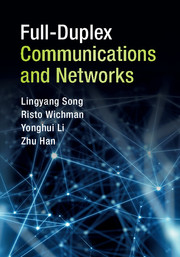Book contents
- Frontmatter
- Dedication
- Contents
- Preface
- 1 Basics of Communication Systems
- 2 Signal Processing and Theoretical Limits
- 3 Full-Duplex System Hardware Implementation
- 4 Full-Duplex MIMO Communications
- 5 Full-Duplex OFDMA Communications
- 6 Full-Duplex Heterogeneous Networks
- 7 Full-Duplex Cooperative Networks
- 8 Full-Duplex Cognitive Radio Networks
- 9 Full-Duplex Random Access Networks
- References
- Index
3 - Full-Duplex System Hardware Implementation
Published online by Cambridge University Press: 16 March 2017
- Frontmatter
- Dedication
- Contents
- Preface
- 1 Basics of Communication Systems
- 2 Signal Processing and Theoretical Limits
- 3 Full-Duplex System Hardware Implementation
- 4 Full-Duplex MIMO Communications
- 5 Full-Duplex OFDMA Communications
- 6 Full-Duplex Heterogeneous Networks
- 7 Full-Duplex Cooperative Networks
- 8 Full-Duplex Cognitive Radio Networks
- 9 Full-Duplex Random Access Networks
- References
- Index
Summary
In this chapter we outline recent hardware development of full-duplex transceivers. The focus is on the development of compact full-duplex transceivers suitable for wireless communication systems. Isolation between the transmitter and receiver chains is limited when using the same antenna for transmitting and receiving. This kind of antenna sharing requires excellent performance of analog and digital cancellation techniques to mitigate self-interference. Therefore, full-duplex technology is more likely to be implemented first in access points and relays that may accommodate separate transmitter and receiver antenna arrays to improve passive isolation. This makes the task of analog and digital cancellation easier, although they are still needed because passive isolation is generally not enough in the case of compact devices. Wireless relays may be preferred, because they have inherent traffic symmetry irrespective of uplink and downlink traffic ratio, and the gains from full-duplex operation are largest when the traffic is symmetric.
Full-Duplex Technology Used in Wireless Systems
In-band full-duplex technology has been utilized in wireless communications systems for a long time in continuous-wave radars and in-channel repeaters in broadcast and cellular systems. Not surprisingly, self-interference has been one of the key challenges in these systems.
Continuous Wave (CW) radar systems use either two separate antennas or one shared antenna to transmit and receive simultaneously [160], whereas pulsed radar systems switch off the transmitter while radar returns are collected. The conventional CW radars of the 1940s and 1950s achieved isolation between the transmitter and receiver through antenna separation-based path-loss in separate-antenna systems, or through the use of circulators in shared-antenna systems. Because only mild levels of isolation could be achieved using these techniques, keeping self-interference to a manageable level required the transmission power to be greatly limited, which then limited the detectable range of targets. This restriction of CWradar to nearby targets (i.e., short ranges) turned out to be useful, because detecting nearby targets with a pulsed radar system would require on/off switching times that are impractically small. Thus, the operational range of CW radars matched their needs.
In the 1960s, an analog circuit-based form of self-interference cancellation was proposed to increase the dynamic range of CW radars [161].
- Type
- Chapter
- Information
- Full-Duplex Communications and Networks , pp. 90 - 108Publisher: Cambridge University PressPrint publication year: 2017



